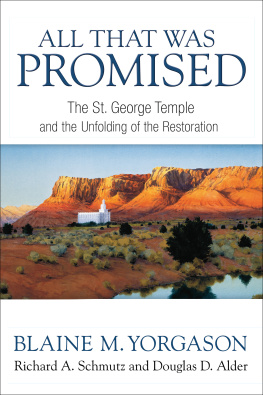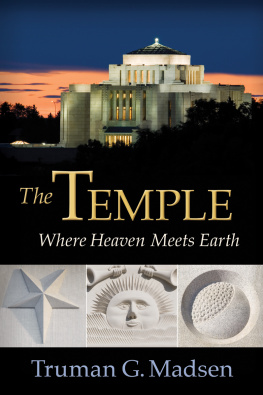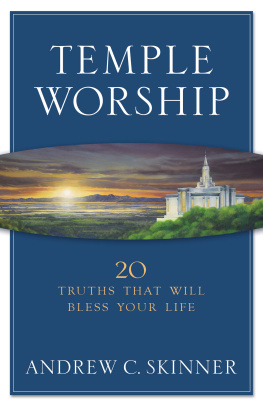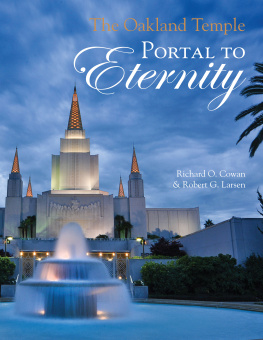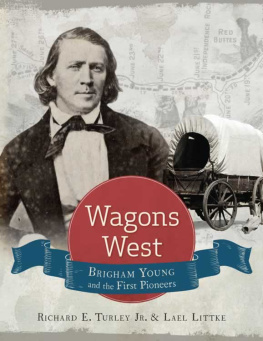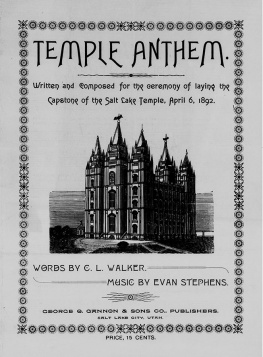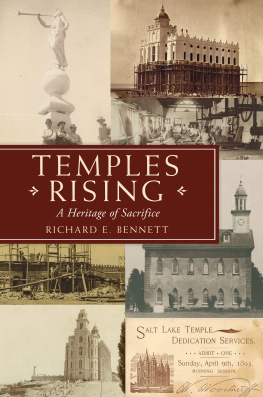All That Was Promised
The St. George Temple and the Unfolding of the Restoration
Blaine M. Yorgason, Richard A. Schmutz, Douglas D. Alder
2013 .
All rights reserved. No part of this book may be reproduced in any form or by any means without permission in writing from the publisher, Deseret Book Company, P.O. Box 30178, Salt Lake City Utah 84130. This work is not an official publication of The Church of Jesus Christ of Latter-day Saints. The views expressed herein are the responsibility of the author and do not necessarily represent the position of the Church or of Deseret Book. Deseret Book is a registered trademark of Deseret Book Company.
Other Books by Blaine Yorgason
Charlies Monument
Finding Mercie
One Tattered Angel
Secrets
Spiritual Survival in the Last Days
The Windwalker
Library of Congress Cataloging-in-Publication Data
Yorgason, Blaine M., 1942 author.
All that was promised : the St. George Temple and the unfolding of the Restoration / Blaine M. Yorgason, with Richard A. Schmutz and Douglas D. Alder.
pages cm
Includes bibliographical references and index.
ISBN 978-1-60907-367-1 (hardbound : alk. paper) 1. St. George Temple (Saint George, Utah)History. I. Schmutz, Richard A., 1925 author. II. Alder, Douglas D., author. III. Title.
BX8685.S34Y67 2013
289.3'79248dc232012047360
Printed in the United States of America
Edwards Brothers Malloy, Ann Arbor, MI
10 9 8 7 6 5 4 3 2 1
In Gratitude
This book is dedicated to the memory of every man, woman, and child who courageously braved the hardships of the desert wilderness in obedience to their prophet and who selflessly gave their all that the St. George Temple might move from fondest dream to sacred reality.
No volume, particularly one that draws from so many personal accounts, is ever compiled without the generous assistance of others. In this case the story of the St. George Temple began with a youthful prophet by the name of Joseph Smith Jr., to whom we and millions of others owe an eternal debt of gratitude on an infinite number of levels, one of which was his worthiness to receive the ministration and sealing keys of Elijah. Then there is Brigham Young, who by the same personal efforts and authority led the newly restored church into the wilderness, and there in the fires of constant adversity forged a cohesive yet earthly kingdom of God. Once he had been called to take the lead in building the first temple in the West, Wilford Woodruff, through personal inspiration and revelation and significant adversity of his own, joined Brigham Young in establishing and codifying all the temple work for both the living and the dead. Such a volume as this could not exist without these three stalwart Church presidents, and we thank them for giving us all this to cherish.
Then came the workers to tiny, primitive, out-of-the-way St. Georgethe builders and laborers in a physical senseperhaps as many as two thousand men and women from throughout the Territory of Utah who accepted calls and came for a winter or for the rest of their lives; it didnt seem to matter to them how long they served, so long as they wore out their lives in service. Next came laborers within the finally dedicated temple who had been called to serve the Lordhundreds and then thousands of men and women who were each called and set apart to administer the sacred ordinances, to record and keep track of the same, to pronounce sealing blessings, and to preside over all the work within the temple as ordinance workers, members of presidencies, matrons, their assistants, recorders, and a host of others. In 2012, more than 2,300 individuals are serving in the St. George Temple, almost all of them volunteers. Our story could never have been told without these wonderfully generous men and women and their families, extending back through the past 140-plus years, and we thank them for their service.
We are grateful also to the numerous men and women who have shared with us personal accounts recorded by their ancestors concerning either their involvement in the settling of St. George and Washington County or in furthering the building of the St. George Temple through the 1870s. While it is not possible to name all the contributors or even to accurately number the men and women who heeded the Lords call to come and build the temple, to each and every one who so contributed, we express our most sincere and heartfelt appreciation.
In spite of our best efforts, however, we recognize that we have not found the records of every man and woman who gave of themselves in the raising up of the St. George Temple. This saddens us, for not only are we certain that many precious and even sacred experiences concerning life in this desert country and the building of the temple have been missed, but we are just as certain that these experiences were as essential to the building of the temple as any we have recorded here. To those individuals we also express our deepest gratitudeand our sincere hope that in a coming day others will locate and compile those records, and all of us will be treated to the sacred witness of their lives and labor.
We are grateful to Jeanine Vander Bruggen, president of the Daughters of Utah Pioneers McQuarrie Memorial Museum board of directors in St. George, Utah. When Jeanine learned of our effort, she went into the museums files, copied dozens and dozens of personal accounts by or about Washington County settlers or temple builders and then hand-delivered them to us so we could push forward the work.
Without each of these mostly unpublished accounts, which ultimately numbered in the hundreds, we could never have told the story of the St. George Temple in such a detailed and personal way. In most cases we have retained the spelling and grammar used by the writers of those accounts in order to convey their respective personalities. We have indicated in the notes the occasional departure from that practice.
Finally, we express gratitude to Cory Maxwell, Richard Peterson, Suzanne Brady, and the staff of Deseret Book Company for their time and efforts, which have ultimately turned a sometimes challenging manuscript into something that we hope will bring honor to all who have ever been a part of the glorious work of the St. George Temple, where all that was promised by the prophet Elijah was finally delivered.
Prologue
Central to the restoration of the gospel was the restoration also of temple ordinances and blessings, which were revealed in the first three latter-day temples, in Kirtland, Nauvoo, and St. George. The prophet Elijah restored the keys of the sealing power in Kirtland in 1836. The first baptisms for the dead and the first endowments and sealings for the living took place in Nauvoo in the early 1840s. The first sealings of children to parents and the first endowments for the dead took place in the St. George Temple in 1877.
Brigham Young had urgently wanted to build the Salt Lake Temple because the Saints had been driven out of Nauvoo before he was able to pass the torch of temple work to his successors. So he had designated that temple site on 28 July 1847, just four days after entering the valley, and the Saints started construction in 1853.
After nearly twenty years of on-again, off-again labor, the construction of the Salt Lake Temple was bogged down in a sea of troubles. Brigham could see that he would not live to view the finished temple, yet he held sacred, confidential information and authority in his hands that he could pass along only in a dedicated temple. So he turned his prophetic eye south, toward St. George.

